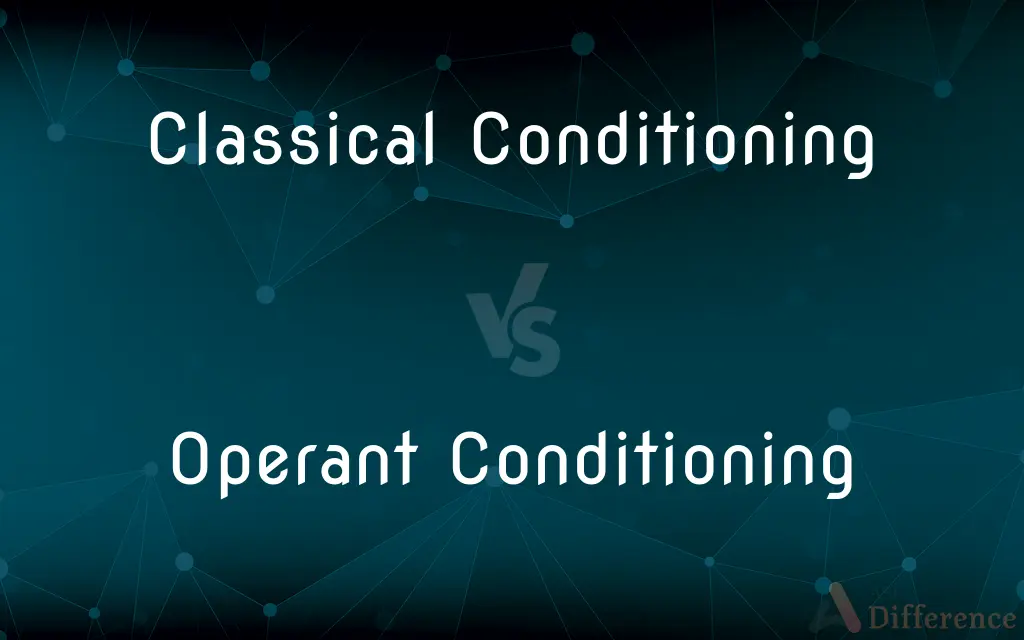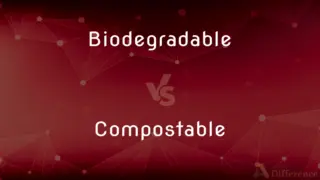Classical Conditioning vs. Operant Conditioning — What's the Difference?
By Tayyaba Rehman — Published on September 26, 2023
Classical Conditioning involves associating an involuntary response with a stimulus, while Operant Conditioning involves reinforcement or punishment after a behavior.

Difference Between Classical Conditioning and Operant Conditioning
Table of Contents
ADVERTISEMENT
Key Differences
Classical Conditioning, pioneered by Ivan Pavlov, involves forming associations between two stimuli. This process typically results in a previously neutral stimulus eliciting a reflexive response. Operant Conditioning, introduced by B.F. Skinner, revolves around strengthening or weakening voluntary behaviors using consequences like rewards or punishments.
In Classical Conditioning, an unconditioned stimulus produces an unconditioned response. When paired with a neutral stimulus, over time, this neutral stimulus becomes conditioned and can elicit the response on its own. Operant Conditioning, conversely, focuses on the relationship between behavior and its consequences, aiming to increase or decrease the likelihood of specific behaviors.
Classical Conditioning predominantly deals with reflexive, involuntary behaviors. An example is a dog salivating at the sound of a bell after associating it with food. Operant Conditioning emphasizes voluntary behaviors, such as a rat pressing a lever to receive food.
A key distinction between Classical Conditioning and Operant Conditioning lies in the type of behaviors they target. While the former conditions reflexive behaviors, the latter conditions voluntary behaviors through the use of reinforcements or punishments.
Both Classical Conditioning and Operant Conditioning provide insights into the mechanisms of learning. They highlight how organisms, from dogs to humans, learn to associate stimuli with responses or understand the implications of their actions based on consequences.
ADVERTISEMENT
Comparison Chart
Behavior Type
Reflexive/involuntary
Voluntary
Pioneering Figure
Ivan Pavlov
B.F. Skinner
Learning Method
Association between stimuli
Consequences following behavior
Examples
Dog salivating to bell sound
Rat pressing a lever for food
Main Components
Unconditioned stimulus/response, conditioned stimulus/response
Behavior, reinforcement/punishment
Compare with Definitions
Classical Conditioning
A learning process where a neutral stimulus becomes associated with a reflexive response.
The dog began to salivate upon hearing the bell due to classical conditioning.
Operant Conditioning
Conditioning focusing on strengthening or weakening voluntary actions.
Operant conditioning techniques were used to teach the dolphin to perform tricks.
Classical Conditioning
Pairing an unconditioned stimulus with a neutral one to produce a conditioned response.
By presenting food with a light flash, the fish responded to the light alone through classical conditioning.
Operant Conditioning
Learning method based on rewards for desired behavior or penalties for undesired ones.
Operant conditioning helped train the monkey to use tokens in exchange for treats.
Classical Conditioning
Learning where two stimuli are linked together to produce a new learned response.
Classical conditioning explained why the cat would hide upon hearing the vacuum's sound.
Operant Conditioning
Using consequences to increase or decrease the likelihood of a behavior's recurrence.
The child would clean his room regularly due to the positive reinforcement in operant conditioning.
Classical Conditioning
Conditioning in which an innate response to one stimulus becomes associated with another.
The baby began to cry at the sight of a white lab coat due to classical conditioning.
Operant Conditioning
Modifying voluntary behaviors by consequences that follow them.
Due to operant conditioning, the dog would sit whenever it wanted a treat.
Classical Conditioning
Associating involuntary behaviors with new stimuli.
Through classical conditioning, the horse began to kick when hearing a specific whistle.
Operant Conditioning
A learning process where behavior is modified using reinforcements or punishments.
The bird learned to peck the colored button for food through operant conditioning.
Common Curiosities
Can Classical Conditioning be unlearned?
Yes, through processes like extinction, where the association between stimuli weakens.
How does Operant Conditioning modify behavior?
It utilizes reinforcements or punishments following a behavior.
Who is associated with the concept of Operant Conditioning?
B.F. Skinner introduced the concept of Operant Conditioning.
What's a famous example of Classical Conditioning?
Pavlov's experiment with dogs, where they salivated at the sound of a bell, demonstrates Classical Conditioning.
Is punishment a part of Operant Conditioning?
Yes, Operant Conditioning can involve both reinforcements and punishments.
How do organisms discern which stimuli to associate in Classical Conditioning?
They often link stimuli that occur closely in time, a principle known as temporal contiguity.
What's a conditioned response in Classical Conditioning?
It's the learned response to the previously neutral stimulus after association.
What is the primary principle of Classical Conditioning?
It involves associating a neutral stimulus with a reflexive response.
Is Classical Conditioning voluntary or involuntary?
Classical Conditioning targets involuntary or reflexive behaviors.
What's an application of Operant Conditioning in everyday life?
Rewarding a child with candy for good behavior is an example of Operant Conditioning.
Can Classical Conditioning occur without conscious awareness?
Yes, often organisms form associations without conscious realization.
Which conditioning uses positive and negative reinforcement?
Operant Conditioning employs both positive and negative reinforcement.
In which conditioning is behavior strengthened by outcomes?
In Operant Conditioning, behaviors are strengthened or weakened by their consequences.
Why is Operant Conditioning significant in behaviorism?
It explains how behaviors can be shaped and maintained by their consequences.
Which conditioning form is more about reflexes and automatic responses?
Classical Conditioning focuses on reflexive and automatic responses.
Share Your Discovery

Previous Comparison
Biodegradable vs. Compostable
Next Comparison
Addon vs. PluginAuthor Spotlight
Written by
Tayyaba RehmanTayyaba Rehman is a distinguished writer, currently serving as a primary contributor to askdifference.com. As a researcher in semantics and etymology, Tayyaba's passion for the complexity of languages and their distinctions has found a perfect home on the platform. Tayyaba delves into the intricacies of language, distinguishing between commonly confused words and phrases, thereby providing clarity for readers worldwide.
















































